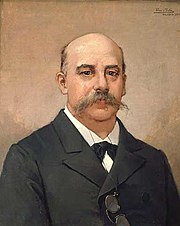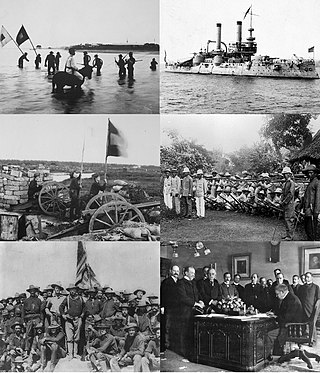
The Spanish–American War began in the aftermath of the internal explosion of USS Maine in Havana Harbor in Cuba, leading to United States intervention in the Cuban War of Independence. The war led to the United States emerging predominant in the Caribbean region, and resulted in U.S. acquisition of Puerto Rico, Guam, and the Philippines. It also led to United States involvement in the Philippine Revolution and later to the Philippine–American War.

Admiral Pascual Cervera y Topete was a prominent Spanish naval officer with the rank of Almirante (admiral) who served in a number of high positions within the Spanish Navy and had fought in several wars during the 19th century. Having served in Morocco, the Philippines, and Cuba, he went on to be Spain's naval minister, chief of naval staff, naval attaché in London, the captain of several warships, and most notably, commander of the Cuba Squadron during the Spanish–American War. Although he believed that the Spanish Navy was suffering from multiple problems and that there was no chance for victory over the United States Navy, Cervera took command of the squadron and fought in a last stand during the Battle of Santiago de Cuba.

Hamilton Fish was an American politician and statesman who served as the 16th governor of New York from 1849 to 1850, a United States senator from New York from 1851 to 1857, and the 26th U.S. secretary of state from 1869 to 1877. Fish was the most trusted advisor to President Ulysses S. Grant and recognized as the pillar of Grant's presidency. He is considered one of the nation's most effective U.S. secretaries of state by scholars, known for his judiciousness and efforts towards reform and diplomatic moderation. He settled the controversial Alabama Claims with the United Kingdom, developing the concept of international arbitration and avoided war with Spain over Cuban independence by coolly handling the volatile Virginius incident. He also organized a peace conference and treaty between South American countries and Spain. In 1875, Fish negotiated a reciprocal trade treaty for sugar production with the Kingdom of Hawai'i, initiating the process which ended in the 1893 overthrow of the House of Kalākaua and statehood. Fish worked with James Milton Turner to settle the Liberia-Grebo War in 1876.
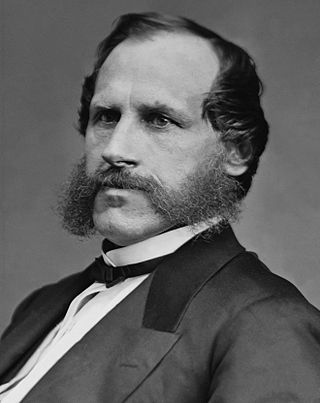
George Henry Williams was an American judge and politician. He served as chief justice of the Oregon Supreme Court, was the 32nd Attorney General of the United States, and was elected Oregon's U.S. senator, and served one term. Williams, as U.S. senator, authored and supported legislation that allowed the U.S. military to be deployed in Reconstruction of the southern states to allow for an orderly process of re-admittance into the United States. Williams was the first presidential Cabinet member to be appointed from the Pacific Coast. As attorney general under President Ulysses S. Grant, Williams continued the prosecutions that shut down the Ku Klux Klan. He had to contend with controversial election disputes in Reconstructed southern states. President Grant and Williams legally recognized P. B. S. Pinchback as the first African American state governor. Williams ruled that the Virginius, a gun-running ship delivering men and munitions to Cuban revolutionaries, which was captured by Spain during the Virginius Affair, did not have the right to bear the U.S. flag. However, he also argued that Spain did not have the right to execute American crew members. Nominated for Supreme Court Chief Justice by President Grant, Williams failed to be confirmed by the U.S. Senate primarily due to Williams's opposition to U.S. Attorney A. C. Gibbs, his former law partner, who refused to stop investigating Republican fraud in the special congressional election that resulted in a victory for Democrat James Nesmith.

Nathaniel Gordon was an American slave trader who was the only person in the United States to be tried, convicted, and executed by the federal government for having "engaged in the slave trade" under the Piracy Law of 1820.
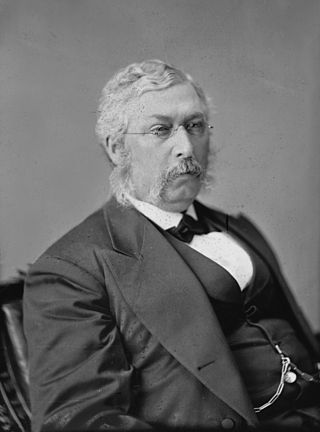
George Maxwell Robeson was an American politician and lawyer from New Jersey. A brigadier general in the New Jersey Militia during the American Civil War, he served as Secretary of the Navy, appointed by President Ulysses S. Grant, from 1869 to 1877. A member of the Republican Party, he also served two terms as a U.S. Representative for New Jersey from 1879 to 1883.

Emilio Castelar y Ripoll was a Spanish republican politician, and a president of the First Spanish Republic.

USS Santiago de Cuba was a side-wheel steamship acquired by the Union Navy during the first year of the American Civil War. She was outfitted as a gunboat with powerful 20-pounder rifled guns and 32-pounder cannon and was assigned to the Union blockade of the Confederate States of America. She was notably successful in this role, capturing several blockade runners. Her last major action of the war was the assault on Fort Fisher, during which seven of her crew won the Medal of Honor.
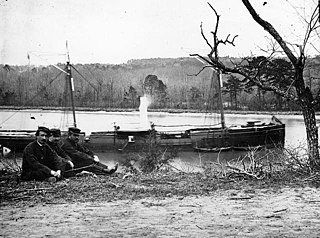
USS Kansas was a gunboat constructed for the Union Navy during the middle of the American Civil War. She was outfitted with heavy guns and assigned to the Union blockade of the waterways of the Confederate States of America. She was the first U.S. Navy ship to be named Kansas and was the first of a class of 836-ton screw steam gunboats. At war's end, she continued serving her country by performing survey work and defending American interests in Cuba until sold in 1883.

The second USS Puritan was a Puritan-class monitor in the United States Navy, constructed in 1882. She was the only ship in her class.

Infanta María Teresa was the lead ship of her class of armoured cruiser constructed for the Spanish Navy. The ship fought at the Battle of Santiago de Cuba during the Spanish–American War.

Furor was a Furor-class destroyer of the Spanish Navy that fought at the Battle of Santiago de Cuba during the Spanish–American War.

Admiral Manuel de la Cámara y Livermoore was a Spanish naval officer. He saw service in many of Spain′s wars of the second half of the nineteenth century and is most notable for commanding a relief squadron that made an abortive attempt to relieve Spanish forces in the Philippine Islands during the Spanish–American War.

The third USS Despatch was a United States Navy steamer in commission from 1873 to 1891.
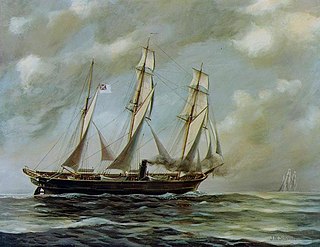
Tornado was a bark-rigged screw steam corvette of the Spanish Navy, first launched at Clydebank, Scotland in 1863, as the Confederate raider CSS Texas. She is most famous for having captured the North American filibustering ship Virginius, which led to the "Virginius Affair", which afterwards led to the Spanish-American Crisis of 1873.

The Capture of the brig Brillante occurred around 1832 and was considered a significant feat in the Blockade of Africa. Brillante was a slave ship that the Royal Navy succeeded in capturing after two failed attempts. The brig had a crew of sixty men and was armed with ten guns. Brillante was under the command of an English-born captain named Homans when she was seized. Homans was an experienced slaver who in ten cruises had landed 5,000 slaves on the coasts of Brazil and Cuba. Brillante reportedly fought at least two battles against the British anti-slavery patrols. She allegedly forced the crew of one British cruiser to abandon ship after a bloody action and on a different occasion, she repulsed boats from a Royal Navy sloop-of-war.
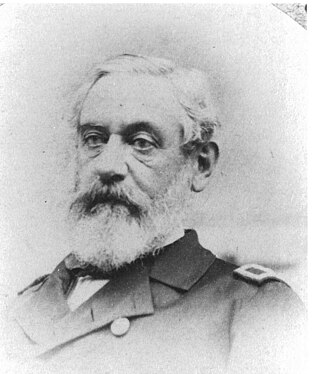
Gustavus Hall Scott was an officer in the United States Navy who served in the Second Seminole War and the American Civil War. He rose to the rank of rear admiral and late in his career was commander-in-chief of the North Atlantic Squadron.

Sir Lambton Loraine, 11th Baronet was a British naval officer, involved in several incidents of gunboat diplomacy. He is best remembered for his involvement in the "Virginius Affair" of 1873.

The history of U.S. foreign policy from 1861 to 1897 concerns the foreign policy of the United States during the presidential administrations of Abraham Lincoln, Andrew Johnson, Ulysses S. Grant, Rutherford B. Hayes, James A. Garfield, Chester A. Arthur, Grover Cleveland, and Benjamin Harrison. The period began with the outbreak of the American Civil War 1861 and ended with the 1897 inauguration of William McKinley, whose administration commenced a new period of U.S. foreign policy.

Rear Admiral José Polo de Bernabé was a Spanish sailor and diplomat.




